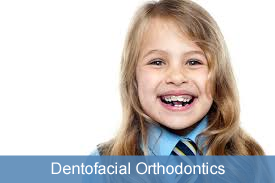 Dentofacial orthopedics involves the guidance of facial growth and development, which occurs largely during childhood. Dentofacial orthopedics is the process of normalizing the growth of a patient’s bone structure and repairing any imbalances of the face and jaws. This process often involves a two-phase treatment and often begins when the patient is around 3 or 4 years old.
Dentofacial orthopedics involves the guidance of facial growth and development, which occurs largely during childhood. Dentofacial orthopedics is the process of normalizing the growth of a patient’s bone structure and repairing any imbalances of the face and jaws. This process often involves a two-phase treatment and often begins when the patient is around 3 or 4 years old.
Dentofacial orthodontics refers to changes in the relative position of the upper or lower jaws in the face. This requires a growing patient (usually children) and special appliances that can affect growing skeletal bone.
Technically speaking, dentofacial orthodontics is the dental specialty that includes the diagnosis, prevention, interception, and correction of malocclusion, as well as neuromuscular and skeletal abnormalities of the developing or mature facial structures.
Dentofacial orthodontics employs special techniques aimed at realigning teeth and jaws. There are several orthodontic treatment alternatives that our NYC orthodontist may use, depending on the results of panoramic x-rays, study models (bite impressions) and a thorough visual examination.
Removable appliances will most likely be used to correct cases of misalignment. These appliances consist of metal wires on an acrylic base that re-train lip and tongue movements along with swallowing and chewing. Such redirected movements stimulate nerve endings so as to direct growth of the upper and lower jaws, which in turn produce the desired outcome.
In general, what percentage of the untreated population would benefit from Orthodontics and/or Dentofacial Orthopedics? *These are approximate percentages and will vary somewhat with different ethnic groups.
- 2% of the population does not need either Orthodontics or Dentofacial Orthodontics. These people have good facial skeletal structures and attractive teeth that function well. 98% of patients would improve their facial appearance with Dentofacial Orthodontics.
- 20% of the population have reasonably good skeletal structure and don’t need Dentofacial Orthodontics. They do need Orthodontics to have better alignment and function of the teeth.
- 75% of the population have skeletal problems that would benefit from Dentofacial Orthodontics. These people also need Orthodontics as part of their total treatment plan.
- 2% of the population have skeletal problems that either do not respond to Dentofacial Orthodontics or are too severe to be handled by means other than oral surgery to correct the skeletal relationship.
What problems can Dentofacial Orthodontics and/or Orthodontics treat?
A wide range of dental problems can be treated. Many of these problems are tied to malocclusion (improper bite). Such a condition can significantly impact the clarity of speech, chewing ability and facial harmony. In addition, a severe malocclusion can also contribute to several serious dental and physical conditions such as breathing difficulties, TMJ or jaw joint disorders, periodontal disease and tooth decay. It is important to seek treatment early to avoid expensive restorative procedures in the future. The orthodontics may work alone but, where necessary, will work in with an orthodontist to solve special problems.
The typical irregularities requiring orthopedic treatment are as follows:
- To achieve harmonic facial proportions.
- To obtain a healthy passage of air and to overcome problems in the TMJ or jaw joint, among other issues.
- Overcrowding: An overcrowded mouth means there is insufficient space within the jaw for all adult teeth to fit naturally. Overcrowding may lead to displaced, rotated or completely misaligned teeth.
- Overbite: An overbite refers to the protrusion of the maxilla (upper jaw) relative to the mandible (lower jaw). An overbite gives the smile a “toothy” appearance and the chin looks like it has receded.
- Underbite: An underbite, also known as a negative underjet, refers to the protrusion of the mandible (lower jaw) in relation to the maxilla (upper jaw). An underbite makes the chin look overly prominent. Developmental delays and genetic factors generally cause underbites and overbites.
- Sleep Apnea: This is caused when soft tissues in the posterior part of the mouth restrict or block the passage of air to the lungs at night. Sleep apnea results in reduced levels of oxygen reaching the bloodstream and the effects can range from daytime drowsiness to congestive heart failure in extreme cases.
If you would like to learn more about Dentofacial Orthodontics please feel contact the best in class, top rated specialist, Dr. Michael Gelb’s NYC or White Plains, New York Gelb Center office today.
The Gelb Center of NYC
635 Madison Avenue, 19th Floor
B/W 59th & 60th Street
New York, NY 10022
P: (212) 752-1662
The Gelb Center of White Plains
244 Westchester Ave, Suite 312
White Plains, NY 10604
P: (914) 686-4528

